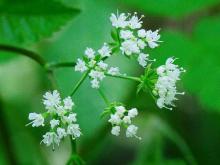Wildflowers, Grasses and Other Nonwoody Plants
Media

Species Types
Scientific Name
Alliaria petiolata
Description
Because each plant disperses a large number of seeds, garlic mustard can outcompete native vegetation for light, moisture, nutrients, soil, and space as it quickly colonizes an area.
Media

Species Types
Scientific Name
Cirsium vulgare
Description
Bull thistle is a weedy introduction from Europe, found statewide. To tell it from our other thistles, note its stems with spiny-margined wings, and its leaves with the upper surface strongly roughened with stiff, spiny bristles.
Media

Species Types
Scientific Name
Cirsium altissimum
Description
Tall thistle is a native thistle that can grow to be 10 feet tall! To identify it, notice its leaves, which are unlobed (though they may be wavy or have only shallow, broad lobes), are felty-hairy beneath, and have prickles only along the edges.
Media

Species Types
Scientific Name
Lamium amplexicaule
Description
In early spring, henbit carpets entire fields with the pinkish-purple of its small flowers. This nonnative mint spreads abundantly but causes few problems. It has shallow roots and fades before crops begin to grow.
Media

Species Types
Scientific Name
Fragaria virginiana
Description
Wild strawberry is one of the parents of the cultivated strawberry and is one of our prized native wild edibles. It’s also a valuable food for innumerable animals, and it’s attractive in native wildflower gardens.
Media

Species Types
Scientific Name
Cunila origanoides
Description
Sometimes called wild oregano, dittany, like true oregano, is a member of the mint family and can be used as a culinary herb and in teas. Look for it on dry, wooded slopes in Ozark counties.
Media

Species Types
Scientific Name
Capsella bursa-pastoris
Description
Shepherd’s purse is a plant that started in Europe and western Asia and has been introduced nearly worldwide. Like the common dandelion, it has several adaptations that make it a successful colonizer of disturbed soil.
Media

Species Types
Scientific Name
Cardamine bulbosa
Description
Like many of its relatives in the mustard family, spring cress has a bitter or pungent flavor, similar to horseradish. It is sometimes used as a condiment and in salads. Or you could just enjoy the pretty white flowers!
Media

Species Types
Scientific Name
Osmorhiza claytonii and O. longistylis
Description
Missouri has two species of sweet cicely, which can be hard to tell apart. Both have umbels of small white flowers, fernlike leaves, and sweetly aromatic, carrotlike roots.
Media

Species Types
Scientific Name
Blephilia ciliata
Description
Square, unbranching stems, opposite leaves, two-lipped flowers, and a mild minty fragrance are clues Ohio horsemint is in the mint family. Tight, rounded flower clusters are stacked atop one another at the stem tips.
See Also
About Wildflowers, Grasses and Other Nonwoody Plants in Missouri
A very simple way of thinking about the green world is to divide the vascular plants into two groups: woody and nonwoody (or herbaceous). But this is an artificial division; many plant families include some species that are woody and some that are not. The diversity of nonwoody vascular plants is staggering! Think of all the ferns, grasses, sedges, lilies, peas, sunflowers, nightshades, milkweeds, mustards, mints, and mallows — weeds and wildflowers — and many more!





















